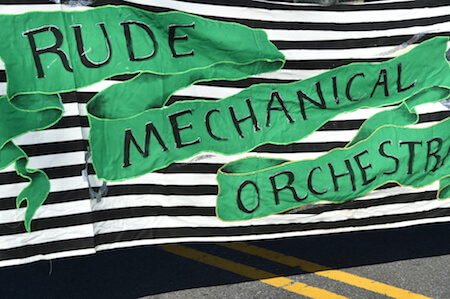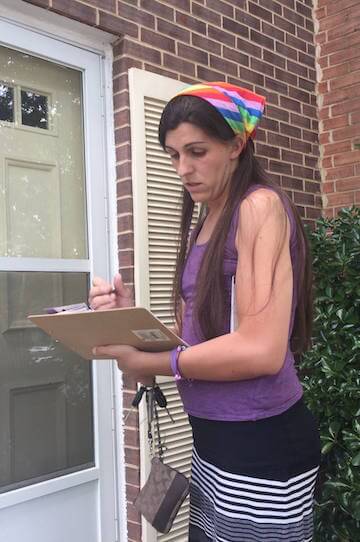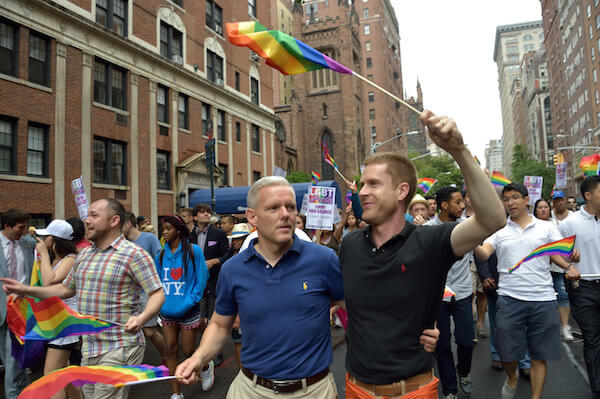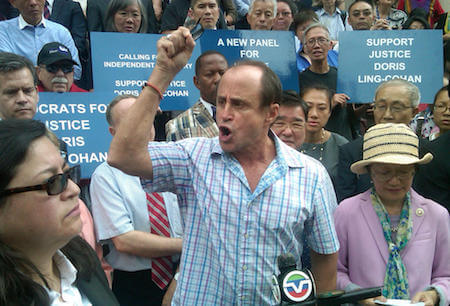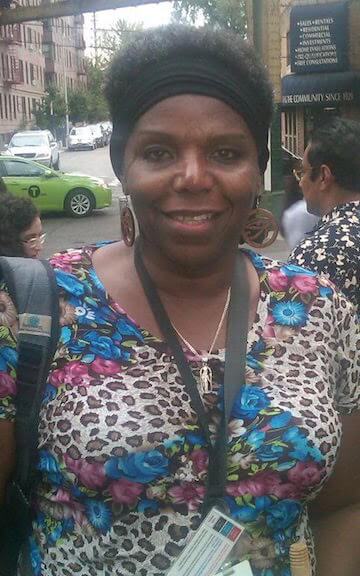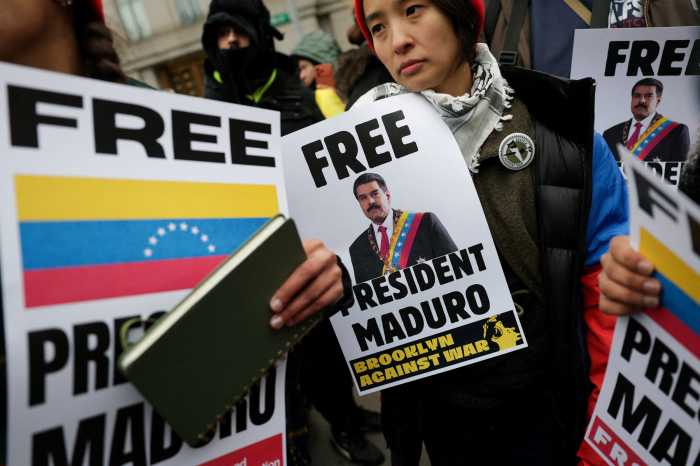Each year, the festivities surrounding the annual St. Pat’s For All parade in Queens seem to expand a bit more. The parade steps off the first Sunday in March, and after wending its way from Sunnyside to Woodside and Jackson Heights its participants fan out to Irish music festival events spread around local bars that keep the fun going well into the evening.
The 17th annual parade, on March 6, was preceded one day before by a sports exchange between the Gaelic Athletic Association and First Nations stickball players from Oklahoma as well as the annual fundraising concert on Friday, hosted by writer/ performer Honor Molloy. The concert featured a variety of acts from Irish and hip-hop dancing to a Chickasaw victory song, with music curated by Brian Fleming.
And on Thursday, March 3, the cultural landscape that made the Queens parade both necessary and possible was permanently altered when Mayor Bill De Blasio announced he would be marching with the Irish LGBT Lavender and Green Alliance in the St. Patrick’s Day Parade on Manhattan’s Fifth Avenue on March 17.
This year, Queens’ lessons in inclusiveness rub off on Manhattan
St. Pat’s for All was founded by Brendan Fay and Kathleen Walsh D’Arcy as an inclusive parade during 1999 and launched the following March, after years of protests and arrests of Irish LGBT people and allies who weren’t welcome in the Fifth Avenue parade. Now that the Lavender and Green Alliance has been officially invited to march down Fifth Avenue, Fay found himself bombarded with questions about whether the Queens parade will continue. Spoiler alert: it will.
“Clearly, the reason for the parade is no longer an issue,” said Fay. “But St. Pat’s for All has taken on a life of its own. It continues to be the most diverse and inclusive celebration of Irish culture in the city.”
The parade’s motto, “Cherishing all the children of the nation equally,” was taken from the proclamation of the Irish Republic in 1916, which itself is now the subject of renewed attention. This marks the centennial of the proclamation and the Easter Rising, the pivotal event that created the modern Irish state. This year’s St. Pat’s For All was also the first since Ireland passed a marriage equality referendum, a victory that reflected the changing nature of Irish culture as well as the way it is perceived internationally.
“The 2016 St. Pat’s for All Parade is one of the most important gatherings ever,” said Barbara Jones, the Irish consul general who helped broker the Fifth Avenue invitation. “It’s always been about cherishing all the children of the nation equally, and on the centennial of the proclamation, we’re celebrating that.”
Award-winning Irish writer Colum McCann, along with Loretta Brennan Glucksman, an Irish-American philanthropist, activist, and co-chair of NYU’s Glucksman Ireland House, served as this year’s grand marshals. For Glucksman, the parade “represents the basic decency and goodness of people who feel excluded but don’t lash out, and their sheer good will draws people over to their point of view.”
McCann said, “It’s the culmination of the past, finally coming to the present. This day is many years too late. It’s a show of great graces, nobody got angry, but they used the parade in a democratic way. The people who did the work for the community are extraordinary. They are saints.”
The unofficial godfather of the parade, actor, writer, and activist Malachy McCourt begged to disagree a bit.
“I’d rather it be a celebration of Irish for All,” he said. “I am not a fan of Patrick, who was not even Irish. He doesn’t represent the Irish spirit of freedom and joy, and he ruined a perfectly good pagan civilization.”
The inheritors of that civilization and the one that followed, as well as friends and allies, gathered on Sunnyside’s Skillman Avenue for the speeches and music before the parade stepped off.
Sunnyside was in fact sunny as an assortment of politicians and other dignitaries stepped to the microphone. Fay welcomed Aidan John and Ace Greenwood from the Choctaw-Chickasaw Cultural Center in Oklahoma, reminding the crowd that the Choctaws had sent food to the Irish during the Great Famine. Fay also remembered the names of the parade supporters who had passed away, including Sandy Boyer, Robert Rygor, Lou Rispoli, Rory Staunton, City Council President Paul O’Dwyer, Barbara Ann Mohr, and Father Mychal Judge.
The grand marshals spoke as did Consul General Jones and then elected officials –– including some who long protested the exclusionary policies of the Fifth Avenue parade such as Queens City Councilembers Daniel Dromm and Jimmy van Bramer. Speaker Melissa Mark-Viverito, addressing the crowd, introduced Bronx Councilmember James Vacca, who recently came out as gay.
Congressmember Joe Crowley spoke movingly of Sir Roger Casement, who was executed for his role in the Easter Rising and outed as a gay man during his trial. Among the other speakers were US Representative Grace Meng, State Senator Michael Gianaris, City Comptroller Scott Stringer, State Comptroller Thomas DiNapoli, Queens Borough President Melinda Katz, and Public Advocate Letitia James. The St. Patrick’s Day Foundation’s Christopher Hyland, representing the Fifth Avenue parade, declared it “a great day for the Irish, marching on the right side of history.”
Daniel Nigro, commissioner of the New York Fire Department, said he was proud to be there, explaining, “I always remember Father Judge” –– the gay fire chaplain who died at the Twin Towers on 9/11 –– and then introducing Ann Kansfield, the openly lesbian FDNY chaplain. Former State Senator Thomas Duane, another longtime supporter of the parade, urged the crowd to support the city’s many Irish cultural institutions.
Mayor De Blasio, who marched in the first St. Pat’s For All Parade as an aide to then-First Lady and US Senate candidate Hillary Clinton, adjusted the microphone a bit higher, then thanked the crowd for coming out on “an amazing day, a joyous, special celebration for a parade that has been an example and a beacon of hope.” The mayor spoke of the “many mothers and fathers” of the agreement between Lavender and Green and the Fifth Avenue parade organizers –– including Fay, Dromm, Jones, members of the Fifth Avenue parade’s committee, and others who broke the deadlock that had blocked LGBT participation for 25 years.
After a performance by the students of the Niall O’Leary School of Irish Dance, the musicians piled onto a truck, and the time for the parade to begin arrived. The FDNY Emerald Society Pipes & Drums Band led off, with skirling pipes and a thunderous beat.
As the parade headed up Skillman Avenue, the crowd –– many of them dressed in green, some wearing Irish accessories from green wigs to shamrock sunglasses –– cheered and called out. Some watched from their front stoops, others brought lawn chairs out to the sidewalk. Many arrived with their dogs, also dressed in costume. The crowd is close enough to the parade that one watcher could catcall de Blasio (“You’re a bum!”), while another ran out into the street with a baby to take a picture with the mayor.
As usual, a few protesters stood along the route with homophobic signs. And as she does every year, one elderly woman held up a sign reading “A Blasphemous Lesbian & Homosexual Parade.”
Girl Scout troops from of Sunnyside, Woodside, and Long Island City were the next to pass by, followed by Dromm’s office and then the Irish Language Speakers of New York and the mayor’s office. A squad from the NYPD’s Gay Officers Action League included an honor guard of their members, many in full dress uniform. The Stonewall Democrats of New York City and Brooklyn’s Lambda Independent Democrats marched just a bit ahead of groups from Stringer and Van Bramer’s offices.
The Lavender and Green Alliance marched behind the banner they’ll use on Fifth Avenue on St. Patrick’s Day, and Manhattan’s Irish Arts Center, which hosted the Friday pre-parade concert, brought a large contingent, led by Aidan Connolly and Pauline Turley. Dublin’s Ray Hegarty led a group with a banner commemorating the Women of 1916, a project he is heading in Ireland for the Centennial, followed by the Woodside/ Sunnyside Runners, many of whom were actually running.
Contingents from James, Crowley, and State Assemblymember Francisco Moya’s offices were followed by members of the Irish Rep Theatre from Manhattan and Pastor Thia Reggio leading a group from Astoria’s First Presbyterian Church.
The FDNY contingent, led by Commissioner Nigro, included the FIREFLAG group and featured five vehicles, including a ladder truck, an ambulance, a vintage truck, and at least one firehouse dog.
The Irish-American Writers & Artists held their banner high, followed by a group of Irish-Americans for Hillary, the Irish-American Democratic Club, and Circle of Voices, a group of Womyn of African Descent and Womyn of Color who create cultural programming.
The band assembled by musical director Brian Fleming, consisting of Dave Barckow, Vonnie Quinn, Jerry Arias and his sons Jaylon and Nick, and Donna Bungo, played traditional Irish and pop tunes from the back of a truck, slowly rolling down the avenue, followed by the Niall O’Leary School of Irish Dance.
A horse-drawn carriage bearing the sign “Irish Heritage: American Icon” followed, signifying the large number of Irish-American New Yorkers who don’t support the removal of the carriages from Central Park.
The McManus School of Irish Dance came next, followed by the Shannon Gaels Gaelic Athletic Association float, housed on a massive truck, followed by youngsters wearing the club’s colors, some riding bikes and doing wheelies.
The Centro Español de Queens brought its own pipe and drum band, and were clad in traditional costumes, featuring peaked velvet hats and kilts. Parade favorite Rapid Rabbit was next to pass by, followed by another longtime participant, a stilt-walking group.
Among the many, many other groups marching were Out Rockaway; the social justice group Loretto at the UN, a
congregation of Catholic nuns and lay co-members; Veterans for Peace; the Gaelic Speakers Society; the Irish-American Brehon Law Society; a group from Jim Thorpe (originally Mauch Chunk), Pennsylvania, in a truck with a sign reading “Pennsylvania Anthracite Coal Region Honors Mother Jones,” the late 19th/ early 20th century Irish-American labor organizer; the Lesbian and Gay Democratic Club of Queens; Queens Pride; Chutney Pride; Brooklyn Pride; Dignity, the LGBT Catholic group; and Labor for Bernie Sanders, handing out voter registration forms reminding voters that the last day to register for the April 19 New York primary is March 25.
The popular anarchist marching band the Rude Mechanical Orchestra –– many of their instruments highlighted with green banners and lights –– drew cheers, as did the Sunnyside Urban Dog Society (SUDS) made up of dozens of dogs and their owners, most –– dogs as well as owners –– wearing Irish-themed costumes. Marching Cobras, a drumline from the Bronx who will also march on Fifth Avenue on March 17, along with their Sapphire Dance Line got the crowd clapping along to their rhythmic beats. A large contingent of uniformed boys and girls made up the Star of the Sea –– Sea Cadet Corps, a youth leadership program, marched in formation.
As the parade drew to a close, the Mother Jones Brigade marched by, holding banners of heroes from Nelson Mandela to their namesake.
The grew group thicker as the parade went up Skillman Avenue, reaching peak numbers at 52nd Street. A tricky left turn at Woodside Avenue, followed by a right onto Roosevelt Avenue signaled the end of the route under the 7 train tracks, across from St. Sebastian School and beneath one of the flight paths from LaGuardia Airport.
The Irish bars closest to the parade’s end soon filled with revelers, from Saints & Sinners to Donovan’s, as marchers quenched their thirst and taste for pub fare. Many prepared to move along to the Irish Music Festival, which was hosted by several more Irish bars –– and this being Queens, a Mexican restaurant, as well –– until “late.”
“What a journey we’ve been on,” said Brendan Fay, speaking of both the day and his 25-year effort to bring inclusiveness to the Fifth Avenue St. Patrick’s parade. “Look how far we’ve come. We’ve created a movement of inclusion.”
He then made a point to credit others –– including Andy Humm, Ann Northrop, and Jesús Lebron –– as activists who’d been by his side on the long, strange trip, which started on the sidewalks of Fifth Avenue, continued in the back of police vans, took the 7 train to Queens, and now returns to walk down Fifth Avenue, a generation later, victorious.

